Rohingya crisis: What life is like inside world’s largest refugee camp
A million people in unsanitary conditions risks spreading infections among local communities and the displaced in Bangladesh. Gaia Vince reports
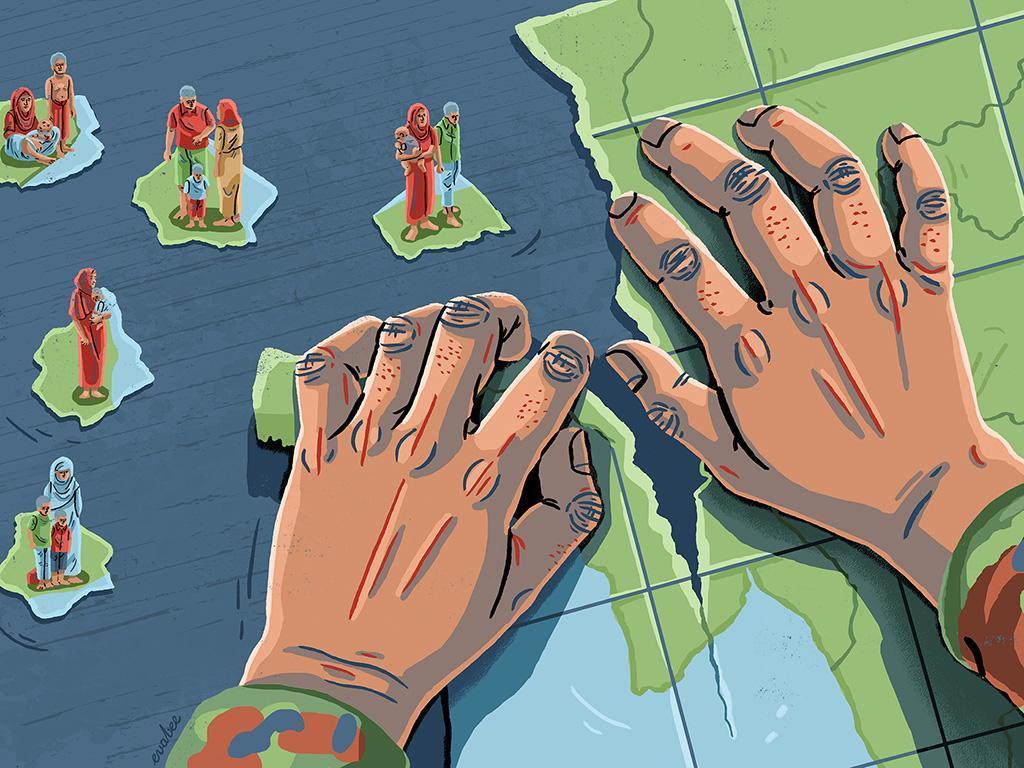
Your support helps us to tell the story
From reproductive rights to climate change to Big Tech, The Independent is on the ground when the story is developing. Whether it's investigating the financials of Elon Musk's pro-Trump PAC or producing our latest documentary, 'The A Word', which shines a light on the American women fighting for reproductive rights, we know how important it is to parse out the facts from the messaging.
At such a critical moment in US history, we need reporters on the ground. Your donation allows us to keep sending journalists to speak to both sides of the story.
The Independent is trusted by Americans across the entire political spectrum. And unlike many other quality news outlets, we choose not to lock Americans out of our reporting and analysis with paywalls. We believe quality journalism should be available to everyone, paid for by those who can afford it.
Your support makes all the difference.Local villagers helped Shamsark off the boat, all but carrying her and her three small children as they stumbled up the slippery bank to safety. She took one look back across the river, through the grey mist to the orange fires of burning Rohingya villages, to where their whole lives had been, where she’d left her husband’s body lying on the ground after he’d been shot.
Then she turned away and led her children through the scrubland to the roadside, joining tens of thousands of other weary refugees clustering around the bright printed logos of international relief organisations.
In Kutupalong camp, near Cox’s Bazar in the far southeast of Bangladesh, Shamsark and her children received emergency food supplies, water and medical attention. She was registered as the female head of household, and given plastic sheeting, matting, bamboo poles and a 10sq-m plot on a bare hillside. Here, she had to try to construct a new life for her surviving family.
Here, in a “town” of nearly 1 million refugees, where only temporary shelters were allowed. Here, where the rain washed the topsoil off deforested hillsides into mudslides. Here, where much of the water was unclean and people often had to slosh knee-deep through mud and human waste.
The risk of infections was high. The children were vaccinated against measles, rubella and polio almost immediately but there were other diseases to worry about, most notably cholera. Many of the aid workers in the camp remembered Haiti after the devastating earthquake in 2010. Ten months later, that country experienced its first cholera outbreak in a century, and it is still going – nearly 10,000 people have died of cholera in Haiti since 2010, and there have been more than 800,000 cases.
The aid agencies in Kutupalong were determined not to let it become another Haiti. An epidemic here of cholera – a highly infectious waterborne disease that thrives in overcrowded, unsanitary living conditions – would be disastrous, and would risk spreading to the local community in Cox’s Bazar, already struggling to adjust after taking in a large number of refugees.
So organisations working in the camp came up with an unprecedented public health intervention: to give every single person a new oral cholera vaccine. It was an enormous undertaking, but it seemed to work. There were no cholera outbreaks.
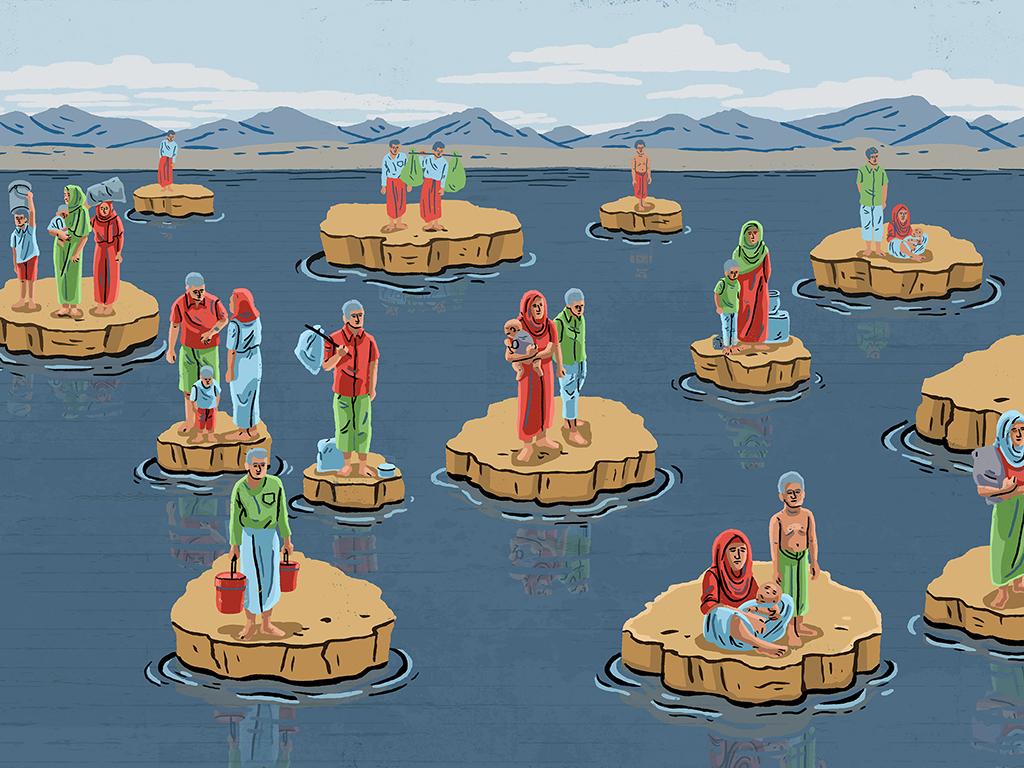
What happened instead took them all by surprise.
* * *
Since the 1960s, the majority Buddhist nation of Myanmar has restricted the movements and rights of its minority ethnic groups. Despite having lived in Myanmar for centuries, the mainly Muslim Rohingya people have been particularly targeted.
Things worsened in 1982, when the Citizenship Law denied the Rohingya citizenship, effectively rendering them stateless. Their rights to marriage, education, health care and employment were severely restricted; many were forced into labour and had their land seized arbitrarily; they lived in extreme poverty, paid excessive taxes and were not allowed to travel freely. Further restrictions in 2012 confined thousands to ghettos and displacement camps, a policy that Amnesty International likened to apartheid. Almost 200,000 Rohingya are estimated to have fled to Bangladesh during these decades of discrimination, but not all were granted refugee status.
200,000
Rohingya estimated to have fled to Bangladesh
Then, on 25 August 2017, the Myanmar military began a coordinated massacre of the Rohingya who remained, delegating much of the violence to unofficial groups of anti-Rohingya militants. In what the United Nations has described as genocide, people were tortured, raped and murdered, their houses burnt and their animals killed.
Shamsark was at home in her village, sleeping. At midnight, gunshots and screams shattered the silence of paddy fields.
With a pounding heart, Shamsark and her husband, Khalad, grabbed their children and ran outside. The village was on fire. As they ran, a staccato of bullets flew at their backs. The air was thick with smoke and Shamsark screamed at her children to hold hands as people fell around them. Four bullets pierced Khalad and he dropped to the ground, bleeding and unconscious.
As the gunmen approached, Shamsark’s neighbours urged her to run with the children. If you can make it to the forest, you will be safe, they told her. We will bring your husband to you.
She just about made it to the forest with the children. Her leg had been injured but it was too dark to see how badly. There were hundreds of people around her, struggling through the undergrowth, all fleeing from their villages towards the banks of the river Naf, the border with Bangladesh. She clutched her children close, urging them on through their tiredness.
When they had made it a safe distance, she stopped. We will wait here for your father, she told the children. As the light came up, it began to rain with the heavy commitment of monsoon. This was rice-planting season – the paddy fields would usually be full of activity, growing the food for the coming months. Shamsark thought of the barren land and the empty bellies of her children.
Slowly the hours of waiting turned to days. Her children cried in hunger and she plucked leaves for them to chew, but sometimes the leaves made them sick, vomiting up what little nutrition they’d had. By the fourth day, Shamsark feared the children would not survive if she didn’t find food, so they followed the trail left by others through the forest.
After two days of walking they reached the riverbank but militants had begun burning parts of the forest and shooting the escaping Rohingya. Panicking, Shamsark took her children back into the forest.
On the eighth day, delirious with hunger and tiredness, she made it to a river crossing. The muddy bank teemed with thousands of people, many injured, dirty and sick. A few small boats were being overloaded with those who could afford to pay. Suddenly, the moans and screams were drowned out by a new sound overhead. Looking up, Shamsark saw a military helicopter about to launch an attack.
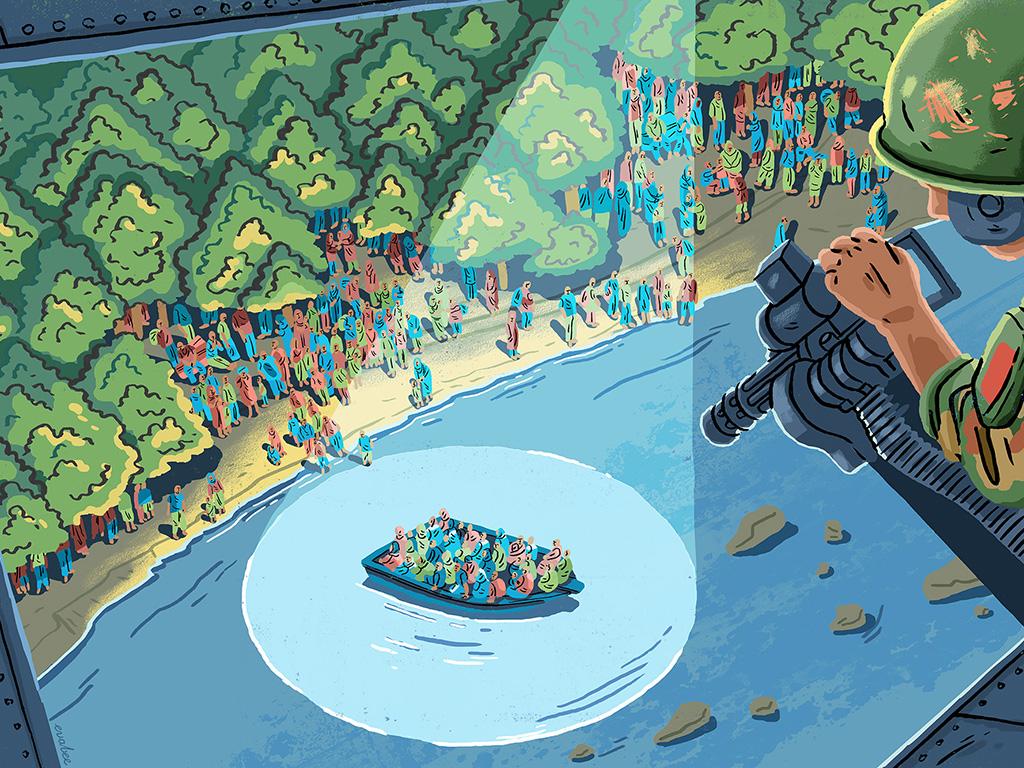
* * *
It was the end of August when the militants reached Feruja’s village. Heavily pregnant and uncomfortable, she was alerted by the smell of burning and restless animals. It wasn’t totally unexpected – there had been rumours, gruesome stories of raids on Rohingya villages. Now it was their turn.
She urgently woke her husband and together they bustled their five children to the door. They heard shouts and gunshots, then screams. Militants were torching their neighbours’ homes and attacking the fleeing occupants with knives.
As her children began running, it became clear that Feruja was in no state to escape. She begged her husband, North, to flee with the children. Instead, he took them all to Feruja’s parents’ house at the far edge of the village. Silently, the family of nine hid in an outhouse, chickens pecking at their feet and screams in their ears.
After an eternity, the village fell silent. In the blackness, North rose to his feet and whispered that it was time to leave. They needed to make it into the forest before daybreak. But Feruja could not stand. Her labour pains had started while they hid, and were now intense: the baby was coming.
At 3am, less than an hour after she’d given birth, North carried Feruja’s bleeding, semi-conscious body out of the house. Her father refused to go with his wife, daughter, son-in-law and now six grandchildren, saying he would rather die there than flee his home. Reluctantly they left him and made their way through the darkness. When they reached the riverbank, they hid there with hundreds of other families.
To Feruja’s joy, her father joined them the next day – seeing the devastation of his ancestral village, he’d realised there was nothing left for him in Myanmar.
After three days, the group set off for the crossing point, where some 5,000 refugees were already waiting to cross to Bangladesh on dangerously overloaded vessels. Boatmen were charging 10,000 Bangladeshi taka (£90) – a fortune for such impoverished people, most of whom had fled their homes with nothing.
£90
Cost for refugee boat to Bangladesh
Feruja’s brother, who was living outside Myanmar, was able to send her the money for passage for the whole family. They were a quarter of the way across when gunmen started firing at them. A bullet hit her four-year-old daughter in the head. Feruja screamed at the boatmen to go faster, as she desperately cradled her bleeding child and her newborn.
* * *
Initial media coverage was followed by mounting reports of atrocities. Footage of thousands of desperate people fleeing burning villages was beamed across the world. Within weeks, hundreds of thousands of survivors had crossed from Rakhine state on the west coast of Myanmar, across the river Naf and into Bangladesh, swelling the number of Rohingya refugees there to over half a million, and more were on their way.
Both Feruja’s and Shamsark’s families were among them having somehow, miraculously, made it to safety – even Feruja’s shot daughter.
Like many others, Mainul Hasan felt compelled to help his fellow Muslims, and, as a doctor and public health specialist living in Dhaka, the capital of Bangladesh, he was in a position to do so. Impulsively he headed to the airport and bought a ticket on the first flight to Cox’s Bazar.
“At that time, I wasn’t involved with any relief organisations, I just came to do some voluntary work, to try to help out. I found some of my former colleagues at MSF [Médecins Sans Frontières], who were already there, so I went to join them,” Hasan says.
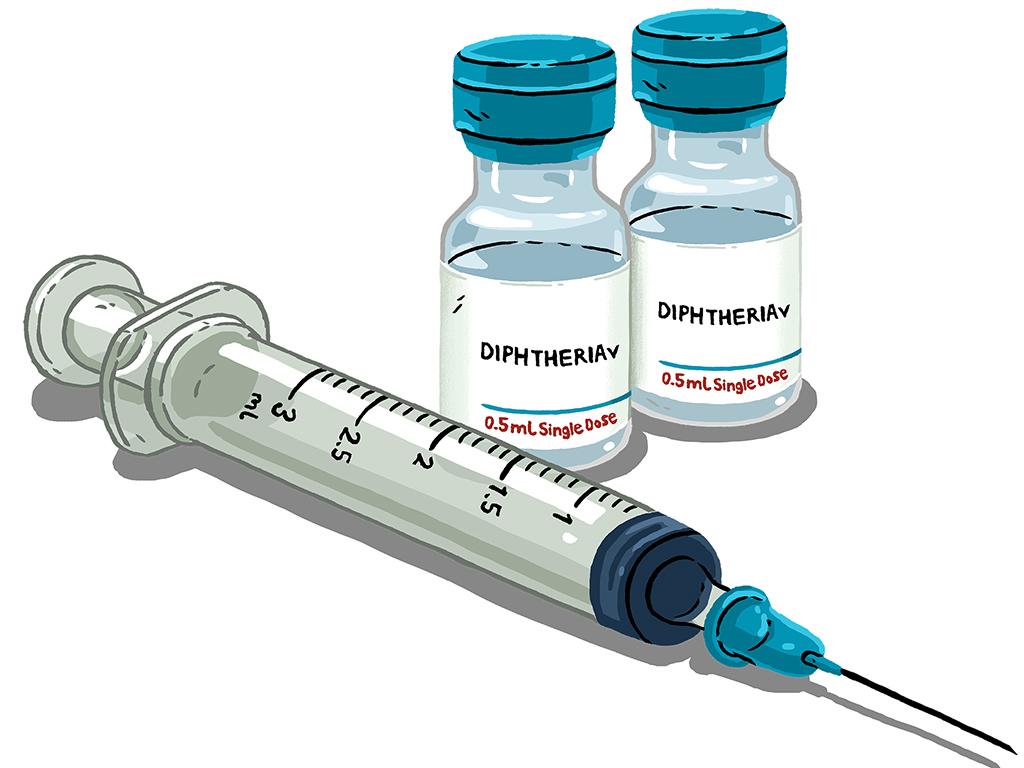
It was an utterly chaotic scene: thousands of refugees arriving daily and nowhere to put them. “People were just standing on the roadside, they had travelled long distances, they were injured, some were carrying other people, and there was no food or anything.”
Donations of food, blankets, medicines and other resources were pouring in from across the nation and the international community, but there was no systematic way of distributing any of it. “People were just throwing food to people at the roadside and people were moving to take it,” Hasan says. Desperate, starved Rohingya arrivals were getting injured in the rush for supplies.
“We were trying to provide treatment, but there were no clinics, so we were just putting down polythene bags in front of us and providing treatment on these,” he says.
We were trying to provide treatment, but there were no clinics, so we were just putting down polythene bags in front of us and providing treatment on these
“There were people with bullet injuries, head injuries, and some who were in severe shock – they couldn’t say anything, they just keep silent, just moving around, and when you’re asking questions then they’re crying. And they’re describing what happened in front of them and that people were killed in front of them, and they saw their houses burned, and they came empty-handed, with nothing.”
* * *
When Feruja and her family arrived at the refugee camp, she had lost a lot of blood and needed urgent medical attention. Her daughter’s head injury needed surgery, but the bullet could not be safely extracted so it was left where it lodged. With little food and poor living conditions, recovery was slow.
Like everyone in the camp, they slept on mats on the bare floor, and ate sparse World Food Programme rations. The army had helped clear a large area of hilly forest for new arrivals – it had previously been used by local villagers for food and to graze animals – and NGOs were sinking hand-pumps to provide water, helping erect shelters, and distributing rations of oil, rice and pulses.
Feruja tried not to think of her spacious family home in Myanmar, her vegetable garden, their 10 cows, their chickens, their fields. The few families who had been able to bring with them items of value – gold smuggled out, sewn into their clothes – could trade it in the fast-emerging markets for vegetables or fruit, which were highly sought-after.
But life for every refugee, whether formerly rich or poor, had been reduced to a few square metres of shelter abutting a stream of sewage-infested runoff water.
Aware of the enormous risk of cholera in these circumstances, on 27 September 2017 the Bangladeshi government made an official request for 900,000 doses of cholera vaccine. The vaccine had been stockpiled since 2013 by an international coordinating group funded by Gavi, the vaccine alliance.
Seth Berkley, head of Gavi, says: “We were gravely concerned by the critical situation they faced and the potential public health disaster that could occur if we didn’t act fast.”
We were gravely concerned by the critical situation they faced and the potential public health disaster that could occur if we didn’t act fast
Approval was given within 24 hours by the coordinating partners, including MSF, the World Health Organisation and Unicef. By October, the enormous vaccination programme was under way to protect hundreds of thousands of Rohingya arrivals in the camp, as well as those outside, mostly Rohingya who had already found shelter among Bangladeshi communities.
The new vaccine could be swallowed rather than injected, but it had to be given twice to be fully effective, so Hasan and his colleagues worked tirelessly day and night to administer one of the largest cholera vaccination programmes in history. “It was a huge effort, to make sure everyone got the first dose and then the next dose, to be protected,” he says.
It was worth it: in spite of the appalling slum conditions and terrible overcrowding, there have been no cholera outbreaks to date. It was a marvellous achievement.
But before the health workers could enjoy their success, several people in the camp developed painful swollen throats. They became feverish, struggling to breathe. More people fell sick. Then they started dying. Rumours about this terrifying disease swept through the deeply traumatised camp. People became increasingly fearful. As medics ran tests to identify the deadly plague, even the health workers were afraid – nobody had seen this sickness before.
* * *
It turned out to be diphtheria. The reason no one recognised it was because diphtheria, once a major killer, had been eradicated from most of the world for decades.
A century ago, diphtheria affected hundreds of thousands of people in the US alone, killing tens of thousands every year. In 2016, there were just 7,097 cases reported globally because nearly 90 per cent of the world’s children are routinely vaccinated against it, using a widely available, cheap and highly effective vaccine.
By the end of 2017, there had been 3,000 suspected cases and 28 deaths in Kutupalong camp and Cox’s Bazar. Why?
3,000
Suspected cases of diphtheria in Kutupalong camp
“This outbreak was not the product of conditions within the camps, but rather a deadly legacy of the conditions in which they had been living before they fled Myanmar,” says Berkley.
It was yet more evidence of the appalling living conditions the Rohingya communities endured in Myanmar – the Buddhist majority received diphtheria protection in their routine childhood vaccines, but most minority ethnic groups did not.
In 2015, Hasan had been part of a team sent by Unicef to assess vaccination coverage in Myanmar in light of a polio outbreak in Rakhine state. He says that the national immunisation level was above 80 per cent, but it had dropped far lower in Rakhine, where most Rohingya lived, because sectarian riots since 2012, and the government crackdown and forced displacements that followed, had disrupted the immunisation programmes. And when not enough children are receiving routine vaccinations, diseases long extinguished across most of the globe can reappear.
That winter, the WHO and Unicef supported a mass polio vaccination programme across affected areas. There were few clinics for the Rohingya, Hasan says, and health workers faced huge issues of distrust – a hostility to officials built up through decades of abuse by the Myanmar authorities. This same distrust made responding to the 2017 diphtheria outbreak more challenging.
Diphtheria can kill 10 per cent of those infected so the agencies had to act fast. Gavi provided urgent supplies for a three-dose immunisation programme for children aged seven to 15 throughout the camp. However, unlike the cholera vaccine, this was not an oral treatment, and the WHO and Unicef teams met resistance when they tried to administer the injections.
Stories flew around about the vaccines. It was said that the injections would make you infertile, or turn you Christian, or make you sick, Hasan tells me.
Aid workers took their time, therefore, even as diphtheria cases continued to soar. They worked with community leaders, going shelter to shelter, building trust and ensuring that children like Feruja’s and Shamsark’s were all protected. Gradually, the vaccination programme succeeded: new cases peaked at a hundred a day in early December, and then fell. The outbreak was contained by January 2018.
* * *
I visit Kutupalong camp at the end of February 2019, 18 months after the massacre. It takes around an hour and a half to drive south from the bustling seaside town of Cox’s Bazar to what quickly became the world’s largest refugee camp, near the Bangladesh–Myanmar border, a journey that hundreds of international aid workers and supply trucks make daily.
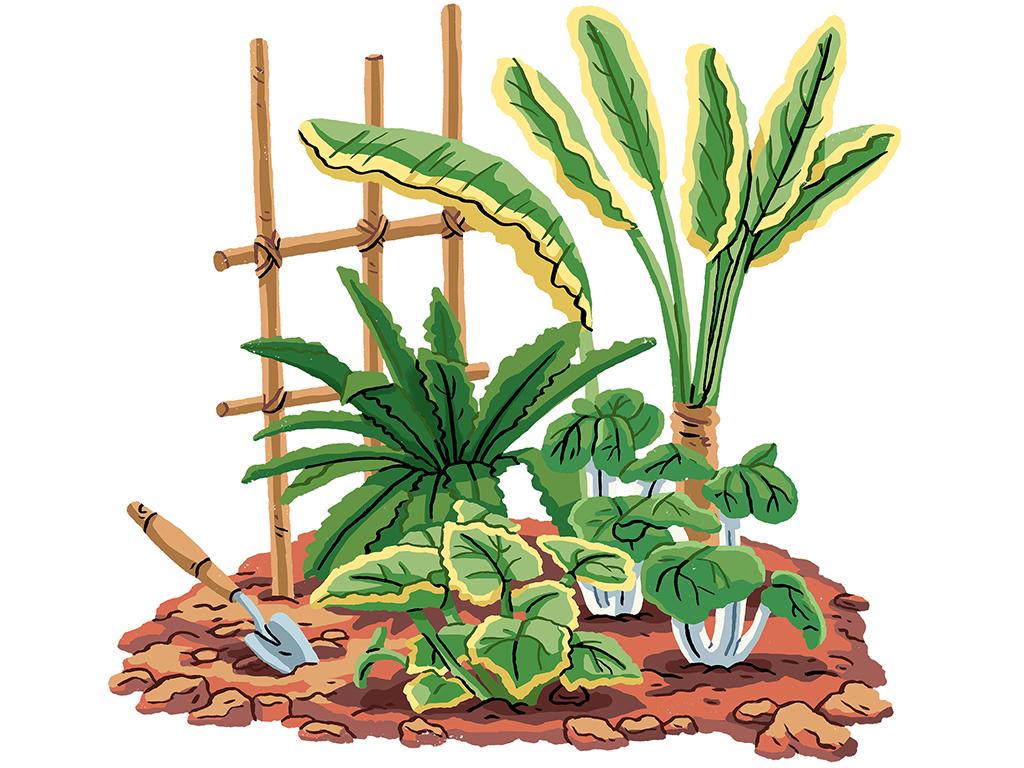
The road is poor and sections of it are frequently closed for repairs – the Unicef vehicle I travel in has to drive along the beach for part of the journey, passing several unlucky cars and rickshaws that have become entrenched in the sand. We pass through small towns and villages, each more impoverished than the last. Children search through piles of rubbish, goats and cows chew on plastic, rice farmers wade through their paddy fields. These are the people who opened their hearts and homes to the thousands of Rohingya, about 80,000 of whom are not in the camp but living with local hosts who took them in.
In fact, the Rohingya tragedy has been devastating for the local community and its environment. Large swathes of the forest have been cleared, the local roads have become dangerously busy, polluted thoroughfares make journeying to school slow and difficult, food prices have soared, wages have fallen, jobs are scarce and people feel insecure.
In a matter of weeks, the local population of 350,000 people accepted almost 1 million migrants. Considering the reaction in Europe (population: 740 million) to the arrival of a similar number of Syrian refugees over many years, it is astonishing how accommodating and generous this community has been. Cox’s Bazar is one of Bangladesh’s poorest districts, and they were told by the government that the Rohingya people would be here for two or three months. One and a half years later, the strain is very apparent.
350,000
Local Bangladeshi population that accepted 1 million Rohingya refugees
It’s easy for a sense of disparity to grow in a community that is struggling while refugees are being given food, healthcare and other assistance. In fact, more than a quarter of aid agencies’ resources here are being directed to helping the local Bangladeshi community. Unicef funds a neonatal unit in Cox’s Bazar that benefits babies born to either community, and during my visit I spot a group of village schoolchildren wearing schoolbags distributed by the same organisation.
Although the Bangladeshi government has generously accommodated the vast numbers of Rohingya, it has not granted them refugee status. Without this status, they are not supposed to leave the camp or work, and they have limited access to education. The Rohingya remain stateless.
The camp has been much improved since its foundation. The army has laid a concrete road through the sprawling site, steps and bridges have been made so people are no longer forced to clamber up muddy hillsides, better shelters have been constructed with concrete bases and bamboo lattice sides (the government still forbids permanent structures), and there are hundreds of concrete latrines.
Nevertheless, this vast sprawling ghetto is a social and environmental calamity. I visit during the dry season, when the untethered soil and sand streams off the hills in the breeze. A thick layer of dust coats everything – it is no surprise that more than half of medical admissions here are for respiratory diseases; after just two hours in the camp, my throat is burning.
Men, women and children while away long hours of unemployed boredom sitting on the ground inside or outside their shelters. Violence, especially against women and girls, is high, as are child marriage and child labour. There have been at least 30 murders, I’m told, and people smuggling is a constant danger for this vulnerable community. Agency workers and visitors like me are under strict curfew, having to leave the camp by 4pm and be back in Cox’s Bazar by sundown.
* * *
Feruja’s daughter is playing in the dirt outside her shelter when I arrive. I see her healed head wound, a circle of satin skin shining in the sun – a small souvenir of a terrifying ordeal that has consumed much of her short life. Poking my head inside the shelter, I pick out Feruja, sitting cross-legged on the floor, backlit by sunlight bleeding through plastic-sheet walls. Her baby, born in exodus, is sleeping next to her on a mat.
In these impoverished surroundings, there is something regal about Feruja’s demeanour, her straight-backed pose, the way her eyes rule the small space, and her unflinching account of the massacre. Now, she tells me, they have safety, but this is not a life. Feruja is haunted by her experiences, battling poor health and malnutrition, yet it is their statelessness that brings out her fury. As citizens of nowhere, the Rohingya are trapped on a bare hillside in a foreign country with no hope.
“I miss my vegetable garden,” she says.
As the uncertainty lingers, aid agencies are trying to alleviate some of the distress of a life lived in limbo. Child-friendly spaces and women’s centres have been set up to provide some informal education, family planning, advice, training and refuge from exploitative domestic situations. In one that I visit, the children are dancing and singing in rehearsal for a performance.
Now that the infrastructure has improved and initial acute health problems, such as severe injuries and epidemics, have been overcome, the aid workers here face the same day-to-day public health challenges of any large slum. Except that here, the community is also burdened with high rates of malnutrition, disability, mental health problems and despair. For children and adults alike, the psychological toll of camp life is compounded by the trauma of the events they experienced during their escape.
* * *
I visit Shamsark’s family shelter through a maze of paths and find her sitting with a baby. She tells me that her children still scream out in the night, reliving terrifying incidents through their nightmares.
In spite of everything, she longs to go back to Myanmar, to live with her four children in their village. She is not interested in revenge or punishing the militants, but, she says, “We have suffered, we have been shot – many were killed – and we want our rights and our ancestral lands.”
Crucially, Shamsark wants citizenship. I hear the same weary demand from every person I speak to. There is still no sign of it being met.
We have suffered, we have been shot – many were killed – and we want our rights and our ancestral lands
While the initial public-health response to the Rohingya’s plight, from both the Bangladeshi government and the international community, was rapid and effective, the longer-term political response has been lacking. The government is now considering plans to move these vulnerable, stateless people to an isolated island, prone to cyclones and flooding, in the Bay of Bengal. The international community must instead support Bangladesh to manage this refugee population sustainably. They need physical and legal security. They need a home.
There has been one bright moment for Shamsark, however.
In November 2017, more than two months after being forced to flee, she was approached by a UNHCR official who asked her to come to a clinic on the other side of the camp. Nervously, she protested that her children had had their vaccinations and were well. Nevertheless, her community leader reassured her and told her to go with the official.
They walked for 30 minutes in near silence until they reached the electrical hum of the clinic’s generators. She followed him inside. “Do you know this man?” he asked her, pointing to a thin, sick man, lying crumpled on a bed.
Shamsark turned and looked. The man, in his early thirties, appeared prematurely old. He had no hair and was wrapped in bandages. Yet she knew him immediately: it was her husband, Khalad, back from the dead. His eyes opened briefly at her shocked exclamation, before closing once more.
After he had been shot, some of the villagers had carried him to safety. Dressing his wounds as best they could, they took him over the forested hills and across the border, where he was rushed to a hospital in the Bangladeshi port city of Chittagong, 90 miles north of Cox’s Bazar.
For weeks, Khalad had been close to death, but eventually he had grown strong enough to be transferred to the camp clinic, where officials had managed to trace his family.
Shamsark was overjoyed – and overwhelmed. Her husband was terribly weak and unable to walk, but he was alive. Her children were no longer fatherless and she was no longer alone.
This article was first published by Wellcome on mosaicscience.com and is republished here under a Creative Commons licence. Sign up to the Mosaic newsletter here.
Join our commenting forum
Join thought-provoking conversations, follow other Independent readers and see their replies
Comments